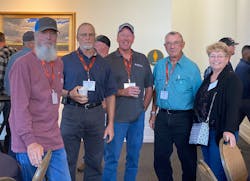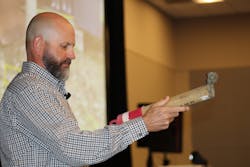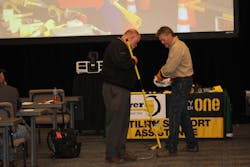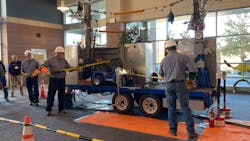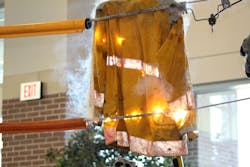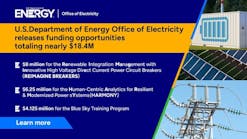The conference, which was sponsored by Circle K Pro and IBEW Locals 47 and 66, had more than 300 registrants, which was a record high for the event, says Mike Hayward of the ILRA. “This safety conference is very important to the board,” he says. “I believe this is year 18, and it is continuing to grow.”
On the second day of the conference, attendees packed the seats and lined the walls of the room to hear the latest research and work methods on safety and training for linemen.
Along with field supervisors, journeymen linemen and apprentices, students in the line program at Metropolitan Community College (MCC) were also in attendance. Susan Blaser says it is the 15th year she and her fellow instructors have brought students to the Rodeo safety conference. Each year, they bring out between 32 and 40 students to participate in the safety conference. In addition, the students serve as bucket truck operators for the hurtman rescue events at the International Lineman’s Rodeo at the National Agricultural Hall of Fame grounds in Bonner Springs, Kansas.
“We come out to the safety conference every year so that our students can participate and learn best practices and stories from others,” says Blaser, who worked in the line trade before joining the teaching faculty at MCC KC. “This will teach them to be safer in the industry and prepare them for what they have in their future.”
Mike Starner, director of outside line safety for the National Electrical Contractors Association (NECA), traveled to Kansas City for the 2022 Lineman’s Rodeo Week after visiting crews restoring power in Florida after Hurricane Ian.
“NECA feels like we are stewards of the industry, and wherever the contractors and workers are, we want to support them,” he says. “By coming to an event like this, you can add some real-world experience and guidance not just for the folks in the field but also safety supervisors. We need to be the community of practice for safety — whether you are working for an IOU, a small co-op, a union contractor or a non-union contractor—we all have to do this together.”
Sharing His Story
To start off the conference, the ILRA invited a lineman to share his personal injury story. This year, Chad Schimpf of Ameren Illinois delivered a presentation about surviving an electrical contact incident.
Back in June 2018, he got a call on a Sunday to help with an outage in a town 40 minutes away. While working on a live switch cabinet, his hand came in contact with an energized fuse. “It took control of my body, and it was like it was in slow motion,” he recalled. “I was on the hill with my hands on the fuse, and I was looking at myself falling.”
Fortunately, he fell backward down the hill away from the fuse. By that time, however, the electricity had already blazed a path through his body from his finger down through his big toes. Schimpf, who used to work as an EMT, immediately called 911 and asked his coworker to take him into town so he could meet the ambulance and get a ride to the hospital. Due to severe weather, he couldn’t get to the hospital in St. Louis on a Life Flight helicopter, so he had to be transported two-and-a-half hours in an ambulance. “Both of my toes were on fire and burning like crazy,” he says. “I thought I was going to die or lose my arm — possibly my legs.”
Instead, he only had to stay in the hospital for 24 hours, and he has no lifelong physical injury from the electrical contact incident. In fact, he was able to compete in an Iron Man marathon just a few weeks after he was hospitalized. He is aware, however, that it could have easily gone the other way. Now that he is working as a safety supervisor, he tries to make a difference and talk to others about the importance of safety.
“There is a lot of pride in the line trade, and you never think something will happen to you,” he says. “But at the same time, we’re always trained to do things the right way. We don’t have to take risks. My company gave me everything we needed to be successful that day. We had the policies in place to kill and ground it, and I had the time and equipment, but I chose not to do it. Now I try to get the guys to be successful in what they do every day.”
Staying Safe in the Heat
Following the personal injury story, the linemen listened to a presentation about heat safety. During his talk, Starner discussed the development of a new heat stress standard and an update on what is happening at the federal OSHA level.
“Right now, there's nothing really on the books, so OSHA wants to go out and enforce heat-related hazards,” he says. “They will have to use the general duty clause, which is the right to have a workplace free from hazards. The problem at the federal level is how do you apply the standard and write a rule that applies to the while country and to different industries?”
The fifth highest cause of injury or death is exposure to harmful substances or environments, which includes heat stress, Starner explained. When working in a hot and humid environment, linemen must look out for signs of heat illness, which includes heat stroke and heat exhaustion. “It’s not just the temperature, but also the humidity and your ability to manage your heat level,” he says.
To stay safe when working in the heat, linemen can check the heat index through an OSHA app, take a break in the shade, cool off in an air-conditioned truck and focus on proper hydration, he says. When it comes to safeguarding linemen from heat stress, Starner says it’s a joint effort. “The employer needs to have a program in place that protects employees, and the employees must take personal responsibility for their health and their actions,” he says.
Safeguarding Linemen
The 2022 Safety & Training Conference also invited vendor representatives to talk to the linemen about how to safely use and maintain their tools and equipment. For example, Phil Doud, safety program manager for Altec, offered strategies for material handling safety for aerial devices. In his presentation, he said it was important for linemen to know their truck’s load weight and measure their load ratings when working out in the field.
Brent Jeffries of Bierer Meters then shared his company’s new nationwide system of safety education for linemen. So far, many industry partners have signed up to participate in the Electric Culture of Safety Program (ECOS), which includes free Webinars and training sessions. He also gave on a hands-on, interactive presentation involving meter equipment and tools.
Rounding out the first day, Rich Gasaway, trainer for Situational Awareness Matters, returned to the Rodeo Safety & Training Conference. During his presentation, he discussed how smart linemen use real situational awareness to improve safety.
Focusing on the Culture of Safety
The following day, Dave Miguel from Underground Safety LLC started off the conference by encouraging the attendees to change their attitude about safety in the line trade. “Most skilled people are so high on their skills and experience,” he says. “The more knowledge and experience we get, unfortunately, laziness comes with it.”
Instead of sleepwalking on the job, linemen need to wake up about the importance of safety and stop being complacent, he says. He shared several examples of how skilled crews made poor decisions and put themselves and their crew members at risk. “The younger hands in the room need to start thinking about what safety means to them,” he says. “At what point are you going to say this is no longer acceptable?”
Demonstrating the Power of Electricity
After Miguel’s presentation, the attendees walked out into the foyer to view a live demonstration from Evergy’s public safety team. Tim Boswell, public safety manager for Evergy, and his team then gave a presentation using their 7,200 V energized trailer, which was introduced in 2010.
“This high-voltage demonstration trailer was built specifically to get inside of facilities where we don’t have to worry about the wind, rain, cold or heat,” he says. “We can make it more of a learning environment.”
The trailer is powered from a generator and pad mount transformer, which allows the trailer to achieve the 7,200 V phase to ground. The team has about 16 demonstrations that they can provide to the public. “They illustrate the hazards associated with electricity and how it can affect the human body if contact is made. Through that visual and verbal education, they’re able to understand that electricity and the human body are not compatible and that every means to isolate, mitigate and protect them from those hazards should be done.”
Currently, 88 linemen across Evergy’s territory are trained to help manage the trailer, and the utility offers about 150 to 160 presentations per year. As such, thousands of customers can see the demonstration and learn from it in both the classroom and live demonstration. Boswell says he felt blessed to be able to be a part of the Lineman’s Rodeo Safety & Training conference.
“The Lineman’s Rodeo has been going on for a long time, and Evergy supports it,” Boswell says. “We feel privileged to share this, especially with young apprentices who get to see it up close and personal. Then they are able to relate to the work that they are doing and understand it from a completely different perspective.”
Protecting Against Arc Flash
To wrap up the 2022 conference, Derek Sang, technical training manager for Bulwark, gave a presentation on flame-retardant clothing and what to do and not do when it comes to arc flash protection. For example, linemen should wear the correct base layers under their FR/AR garments. Also, they should consider wearing two lightweight FR/AR garments rather than a single heavier layer for more comfort and protection.
Following the Rodeo Safety & Training Conference, the linemen rode the escalator up to the second floor to line up for the 2022 Lineman’s Expo at the convention center. As they flooded into the exhibit hall, they could see the latest in tools and technology as well as new FR garments and personal protective equipment from gloves to boots to hard hats.
Donnie Jones, an electric crew leader at MidAmerican Energy, says his company brought three journeyman teams and three apprentices to the Rodeo Week. “I’m really excited about all the vendors that I’m seeing this year and all the people that are here,” he says. “I’ve been coming here about 14 years, and it’s exciting to see all the growth here.”
Editor’s Note: To see a photo gallery from the safety conference, visit the T&D World Web site at www.tdworld.com/electric-utility-operations.
.

